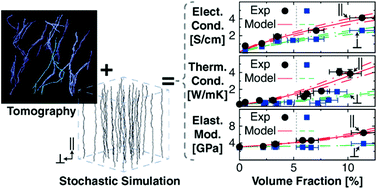Aligned carbon nanotube morphogenesis predicts physical properties of their polymer nanocomposites†
Abstract
Carbon nanostructure (CNS) based polymer nanocomposites (PNCs) are of interest due to the superior properties of the CNS themselves, scale effects, and the ability to transfer these properties anisotropically to the bulk material. However, measurements of physical properties of such materials are not in agreement with theoretical predictions. Recently, the ability to characterize the 3D morphology of such PNCs at the nanoscale has been significantly improved, with rich, quantitative data extracted from tomographic transmission electron microscopy (TEM). In this work, we use new, nanoscale quantitative 3D morphological information and stochastic modeling to re-interpret experimental measurements of continuous aligned carbon nanotube (A-CNT) PNC properties as a function of A-CNT packing/volume fraction. The 3D tortuosity calculated from tomographic reconstructions and its evolution with volume fraction is used to develop a novel definition of waviness that incorporates the stochastic nature of CNT growth. The importance of using randomly wavy CNTs to model these materials is validated by agreement between simulated and previously-measured PNC elastic moduli. Secondary morphological descriptors such as CNT–CNT junction density and inter-junction distances are measured for transport property predictions. The scaling of the junction density with CNT volume fraction is observed to be non-linear, and this non-linearity is identified as the primary reason behind the previously unexplained scaling of aligned-CNT PNC longitudinal thermal conductivity. By contrast, the measured electrical conductivity scales linearly with volume fraction as it is relatively insensitive to junction density beyond percolation. This result verifies prior hypotheses that electrical conduction in such fully percolated and continuous CNT systems is dominated by the bulk resistivity of the CNTs themselves. This combination of electron tomographic data and stochastic simulations is a powerful method for establishing a predictive capability for nanocomposite structure–property relations, making it an essential aid in understanding and tailoring the next-generation of advanced composites.



 Please wait while we load your content...
Please wait while we load your content...